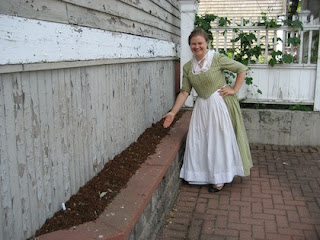I found it at the Knaut-Rhuland House museum in Lunenburg, Nova Scotia.
The textile room at the back holds a comprehensive collection of tools and supplies that museum interpreters must find well-suited to teaching the public about hand methods of fabric production. There is a great wheel with bat head, loom, inkle loom, warping board, spinning wheel, line flax, baskets of wool, basket of spindles and roving, swift, skein winder, hand cards for wool, handwoven fabric samples, a crude Turkish spindle made from twigs, and an enormous rustic forked distaff whose practicality I question. I was interested the line flax, of course, but sadly wasn't able to find out where the flax came from.
 |
| bat head on great wheel |
 |
| decorative paint on spinning wheel; line flax |
Also upstairs was a very old set of table linen labeled as a flax linen centre and serviettes. (Canadians say serviettes, Americans say napkins. I remember my Canadian-born grandmother once defended the word serviette, clinching her argument with the fact that napkins, nappies, go on babies' bottoms.) The set was made locally by hand at every stage from flax seed planted by a settler who came to the area in the mid-1700s. I won't post a photo of the linens because they are from a private collection on loan to the museum, but I will describe the workmanship. The material is fine, even, and smooth. Extensive embellishment was done in cutwork; that is, small holes were cut out in patterns and the edges bound with embroidery in the shape of leaves and flowers. Vines and blossoms are embroidered on the solid parts. I can't imagine anyone daring to wipe a greasy mouth with one of those serviettes.
In the narrow garden around the house were small sprouts, identified by the museum worker as flax, as well as dye plants at the back.



No comments:
Post a Comment
please use your good sense when commenting to protect your privacy and respect other people, thanks. No spam, please.